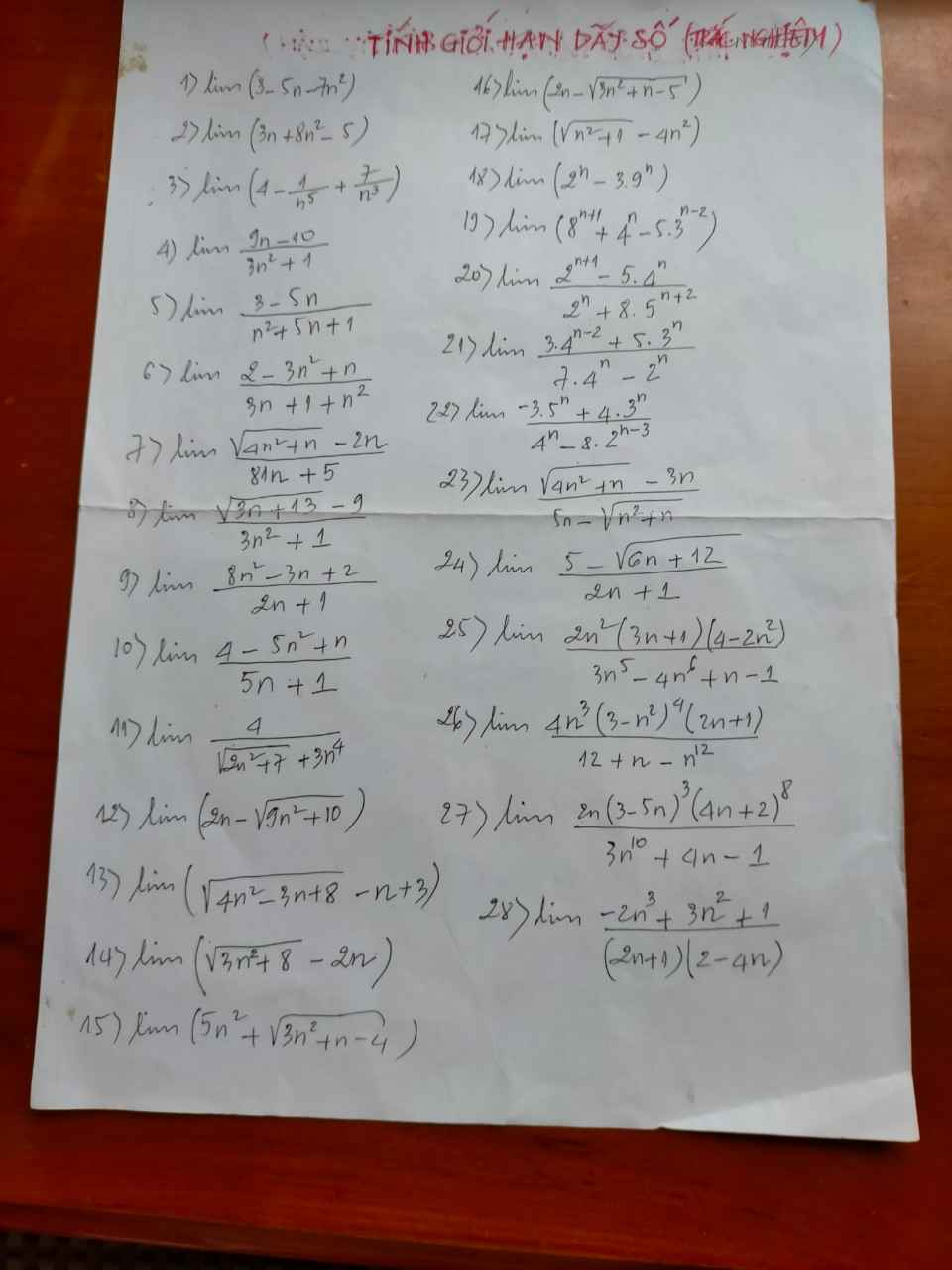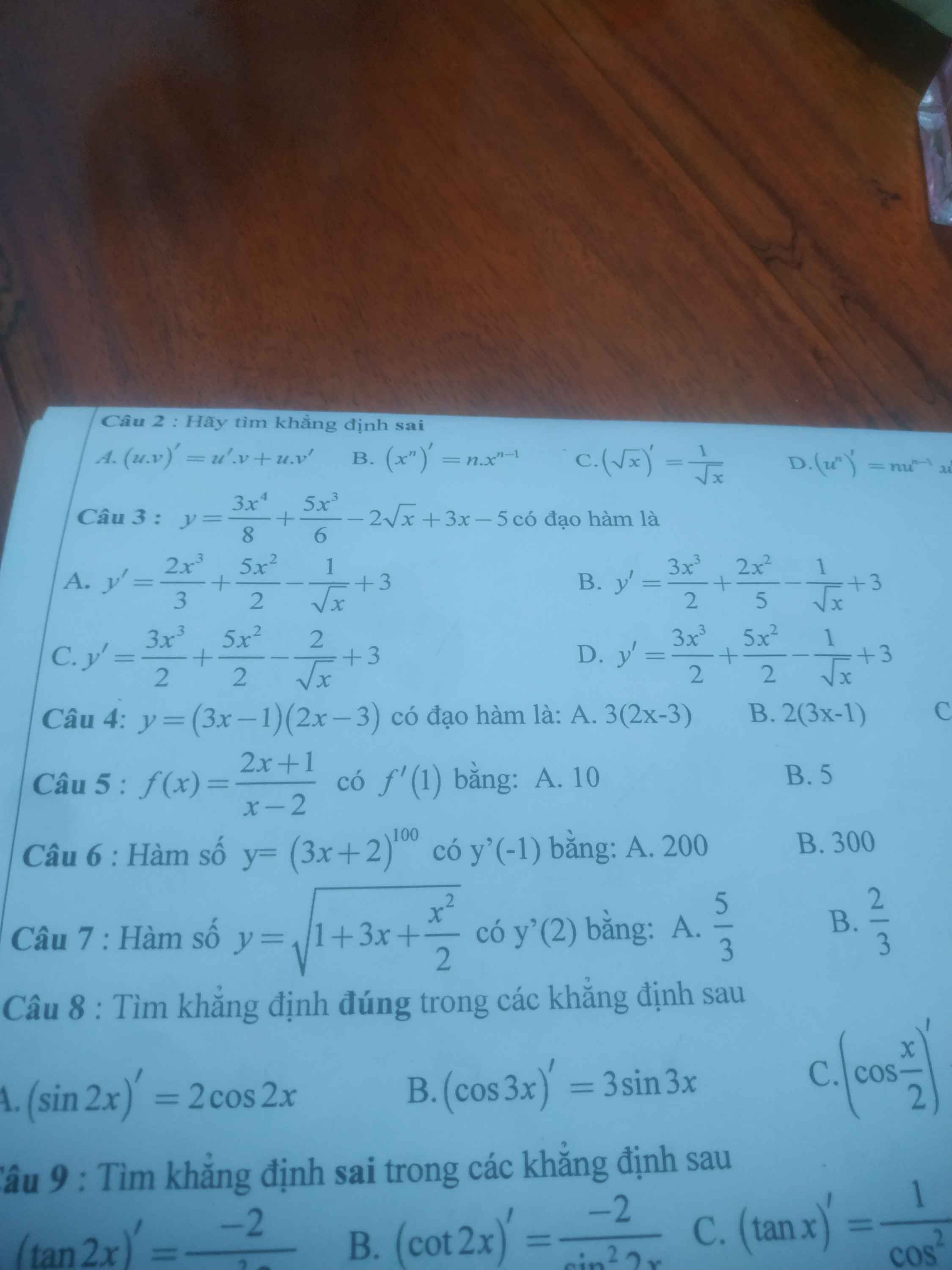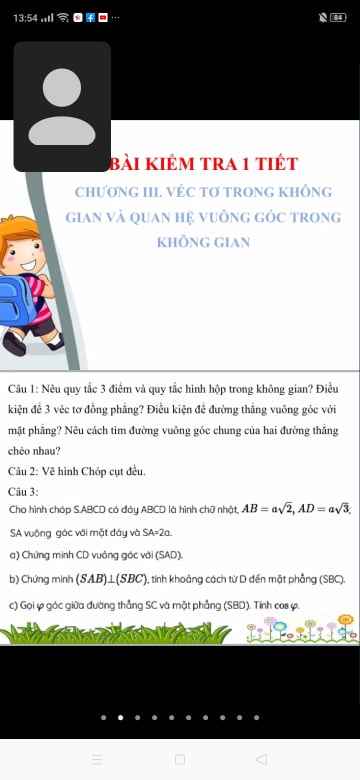
Hãy nhập câu hỏi của bạn vào đây, nếu là tài khoản VIP, bạn sẽ được ưu tiên trả lời.


3:
a: CD vuông góc AD
CD vuông góc SA
=>CD vuông góc (SAD)
b: BC vuông góc AB
BC vuông góc SA
=>BC vuông góc (SAB)
=>(SBC) vuông góc (SAB)

12.
\(y=\sqrt{2}sin\left(2x+\dfrac{\pi}{4}\right)\le\sqrt[]{2}\)
\(\Rightarrow M=\sqrt{2}\)
13.
Pt có nghiệm khi:
\(5^2+m^2\ge\left(m+1\right)^2\)
\(\Leftrightarrow2m\le24\)
\(\Rightarrow m\le12\)
14.
\(\Leftrightarrow\left[{}\begin{matrix}cosx=1\\cosx=-\dfrac{5}{3}\left(loại\right)\end{matrix}\right.\)
\(\Leftrightarrow x=k2\pi\)
15.
\(\Leftrightarrow\left[{}\begin{matrix}tanx=-1\\tanx=3\end{matrix}\right.\)
\(\Rightarrow\left[{}\begin{matrix}x=-\dfrac{\pi}{4}+k\pi\\x=arctan\left(3\right)+k\pi\end{matrix}\right.\)
Đáp án A
16.
\(\dfrac{\sqrt{3}}{2}sinx-\dfrac{1}{2}cosx=\dfrac{1}{2}\)
\(\Leftrightarrow sin\left(x-\dfrac{\pi}{6}\right)=\dfrac{1}{2}\)
\(\Leftrightarrow\left[{}\begin{matrix}x-\dfrac{\pi}{6}=\dfrac{\pi}{6}+k2\pi\\x-\dfrac{\pi}{6}=\dfrac{5\pi}{6}+k2\pi\end{matrix}\right.\)
\(\Leftrightarrow\left[{}\begin{matrix}x=\dfrac{\pi}{3}+k2\pi\\x=\pi+k2\pi\end{matrix}\right.\)
\(\left[{}\begin{matrix}2\pi\le\dfrac{\pi}{3}+k2\pi\le2018\pi\\2\pi\le\pi+k2\pi\le2018\pi\end{matrix}\right.\) \(\Rightarrow\left[{}\begin{matrix}1\le k\le1008\\1\le k\le1008\end{matrix}\right.\)
Có \(1008+1008=2016\) nghiệm

1.
\(\Leftrightarrow\sqrt{2}sin\left(x-\dfrac{\pi}{4}\right)=0\)
\(\Leftrightarrow sin\left(x-\dfrac{\pi}{4}\right)=0\)
\(\Leftrightarrow x-\dfrac{\pi}{4}=k\pi\)
\(\Leftrightarrow x=\dfrac{\pi}{4}+k\pi\)
2.
\(\Leftrightarrow\sqrt{2}sin\left(x+\dfrac{\pi}{4}\right)=1\)
\(\Leftrightarrow sin\left(x+\dfrac{\pi}{4}\right)=\dfrac{\sqrt{2}}{2}\)
\(\Leftrightarrow\left[{}\begin{matrix}x+\dfrac{\pi}{4}=\dfrac{\pi}{4}+k2\pi\\x+\dfrac{\pi}{4}=\dfrac{3\pi}{4}+k2\pi\end{matrix}\right.\)
\(\Leftrightarrow\left[{}\begin{matrix}x=k2\pi\\x=\dfrac{\pi}{2}+k2\pi\end{matrix}\right.\)
3.
\(\Leftrightarrow\left(sin^2x+cos^2x\right)^2-2sin^2x.cos^2x=\dfrac{5}{8}\)
\(\Leftrightarrow1-\dfrac{1}{2}sin^22x=\dfrac{5}{8}\)
\(\Leftrightarrow1-\dfrac{1}{2}\left(\dfrac{1}{2}-\dfrac{1}{2}cos4x\right)=\dfrac{5}{8}\)
\(\Leftrightarrow\dfrac{3}{4}+\dfrac{1}{4}cos4x=\dfrac{5}{8}\)
\(\Leftrightarrow cos4x=-\dfrac{1}{2}\)
\(\Leftrightarrow\left[{}\begin{matrix}4x=\dfrac{2\pi}{3}+k2\pi\\4x=-\dfrac{2\pi}{3}+k2\pi\end{matrix}\right.\)
\(\Leftrightarrow\left[{}\begin{matrix}x=\dfrac{\pi}{6}+\dfrac{k\pi}{2}\\x=-\dfrac{\pi}{6}+\dfrac{k\pi}{2}\end{matrix}\right.\)

Câu 10:
$\sin ^2x=0\Leftrightarrow \sin x=0$
$\Rightarrow x=k\pi$ với $k$ nguyên.
Trong các khoảng đã cho chỉ có khoảng ở đáp án A chứa $k\pi$ với $k$ nguyên.
Câu 11:
PT\(\Leftrightarrow 2\sin x\cos x-\sin x-2+4\cos x=0\)
\(\Leftrightarrow 2\cos x(\sin x+2)-(\sin x+2)=0\)
\(\Leftrightarrow (2\cos x-1)(\sin x+2)=0\)
Vì $\sin x\geq -1$ nên $\sin x+2\geq 1>0$
$\Rightarrow 2\cos x-1=0$
$\Leftrightarrow \cos x=\frac{1}{2}=\cos \frac{\pi}{3}$
$\Rightarrow x=\frac{\pi}{3}+2k\pi$ hoặc $x=-\frac{\pi}{3} +2k\pi$ với $k$ nguyên.
Đáp án B.

4a.
Do d' là ảnh của d qua phép tịnh tiến nên d' cùng phương d
\(\Rightarrow\) Phương trình d' có dạng: \(x+3y+c=0\)
Lấy \(A\left(1;0\right)\) là 1 điểm thuộc d
\(T_{\overrightarrow{v}}\left(A\right)=A'\Rightarrow\left\{{}\begin{matrix}x'=2+1=3\\y'=0-1=-1\end{matrix}\right.\) \(\Rightarrow A'\left(3;-1\right)\)
Thay tọa độ A' vào pt d' ta được:
\(3+3.\left(-1\right)+c=0\Rightarrow c=0\)
Hay pt d' có dnagj: \(x+3y=0\)
8a.
Đường tròn (C) tâm \(I\left(2;-1\right)\) bán kính \(R=\sqrt{2^2+\left(-1\right)^2+3}=\sqrt{8}\)
Gọi (C') là ảnh của (C) qua phép tịnh tiến, với \(I'\left(x';y'\right)\) và R' lần lượt là tâm và bán kính (C')
Ta có:
\(\left\{{}\begin{matrix}R'=R=\sqrt{8}\\T_{\overrightarrow{v}}\left(I\right)=I'\end{matrix}\right.\)
\(\Rightarrow\left\{{}\begin{matrix}x'=2+3=5\\y'=-1+\left(-4\right)=-5\end{matrix}\right.\)
\(\Rightarrow I'\left(5;-5\right)\)
Phương trình (C') có dạng: \(\left(x-5\right)^2+\left(y+5\right)^2=8\)

9, f'(x) = \(m^3-3m^2+m\) = 3
\(\Rightarrow m\in\left\{1;-1;3\right\}\)











1.
\(\lim\left(3-5n-7n^2\right)=\lim n^2\left(\dfrac{3}{n^2}-\dfrac{5}{n}-7\right)\)
Do \(\lim n^2=+\infty\)
\(\lim\left(\dfrac{3}{n^2}-\dfrac{5}{n}-7\right)=0-0-7=-7< 0\)
\(\Rightarrow\lim n^2\left(\dfrac{3}{n^2}-\dfrac{5}{n}-7\right)=-\infty\)
2.
\(\lim\left(3n+8n^2-5\right)=\lim n^2\left(\dfrac{3}{n}+8-\dfrac{5}{n^2}\right)\)
Do \(\lim n^2=+\infty\)
\(\lim\left(\dfrac{3}{n}+8-\dfrac{5}{n^2}\right)=0+8-0=8>0\)
\(\Rightarrow\lim n^2\left(\dfrac{3}{n}+8-\dfrac{5}{n^2}\right)=+\infty\)
3.
\(\lim\left(4-\dfrac{1}{n^5}+\dfrac{7}{n^3}\right)=4-0+0=4\)